Leeds United are now the leaders of the EFL Championship. For the past 2 years, some magnificent changes have occurred under Marcelo Bielsa. ‘El Loco’ has previous experience in Ligue 1 and La Liga, and the Argentine frequently receives praise from Manchester City manager Pep Guardiola and other elite-level managers.
Pressing and possession are two key weapons for Marcelo Bielsa. Under the tactics of Bielsa, one player is able to play in various positions and starts in all 37 games: the versatile Stuart Dallas. He has not missed a game and has played for 3715 minutes this season as left-back, right back, and also in midfield.
The reason for him playing in several positions is because of Luke Ayling’s injury at the beginning of the season, so Dallas filled in at right-back. Then Adam Forshaw, Pablo Hernandez, and Jamie Shackleton all found themselves on the treatment table. Bielsa deployed Dallas more frequently as a midfielder. Finally, he was moved to left-back as he has experience in that position from the end of last season and Barry Douglas and Ezgjan Alioski had been inconsistent.
However, what attributes allow him to play several positions under Marcelo Bielsa’s tactics? What does he do in different positions? These are the two questions we are about to solve in this analysis.
In this tactical analysis, in the form of a scout report, we will first examine Stuart Dallas’ abilities and traits that make him fit into different positions for Leeds United. Then we will combine his attributes and Leeds United’s tactics to further discuss his role and contribution for his team when he plays in different positions.
Overview
Leeds United are a possession-based attacking team. They have an average of 62.8% of possession per game which ranks first in the EFL Championship. They want to dominate possession and recover the ball quickly when they are out of possession. They also adopt a high press and press with high intensity when losing the ball, with a PPDA (passes per defensive action) of 6.30 per 90 which also ranks them first in the league.
Stuart Dallas frequently plays three positions for his team: left-back, right-back, and central midfielder in a 4-1-4-1 formation. In general, his ability on the ball is quite good. He can use both feet to receive and then pass forwards under pressure, which fits Leeds United’s tactics since they emphasise a lot on keeping possession. Furthermore, Dallas also uses an aggressive approach to defence. He is front-footed and always looks to regain possession, which also fits the tactics of the team. Now let’s take a closer look at how he performs in some aspects and how he plays in different positions.
Touches
As I mentioned above, Leeds United base their tactics on dominating possession. Hence why they need players who are comfortable on the ball and receiving when under pressure and are able to pass forwards when they are pressed. Furthermore, Leeds United will try to play out from the back under pressure. That means players are required to have the ability to receive and pass the ball whilst still keeping possession in a tight area. They are also required to be composed with the ball near the sideline and take as few touches as possible to play out of a tricky situation, as this helps Leeds play quicker football and helps in ball progression, which will be discussed later.
Dallas has the exact qualities that Leeds United require. He is right-footed but he is comfortable playing with his left, which gives him more options when he is under pressure. Dallas’ natural style is that of a player who takes few touches and likes who plays it simple. He often receives the ball on the half-turn in order to beat his man.
Normally when he plays as a full-back, he opens his body up in advance, ready to receive the ball. Then as the ball approaches him, he takes his first touch forwards, and with his second touch, he looks to pass forwards. Now let’s take a look at an example of him playing as a left-back.
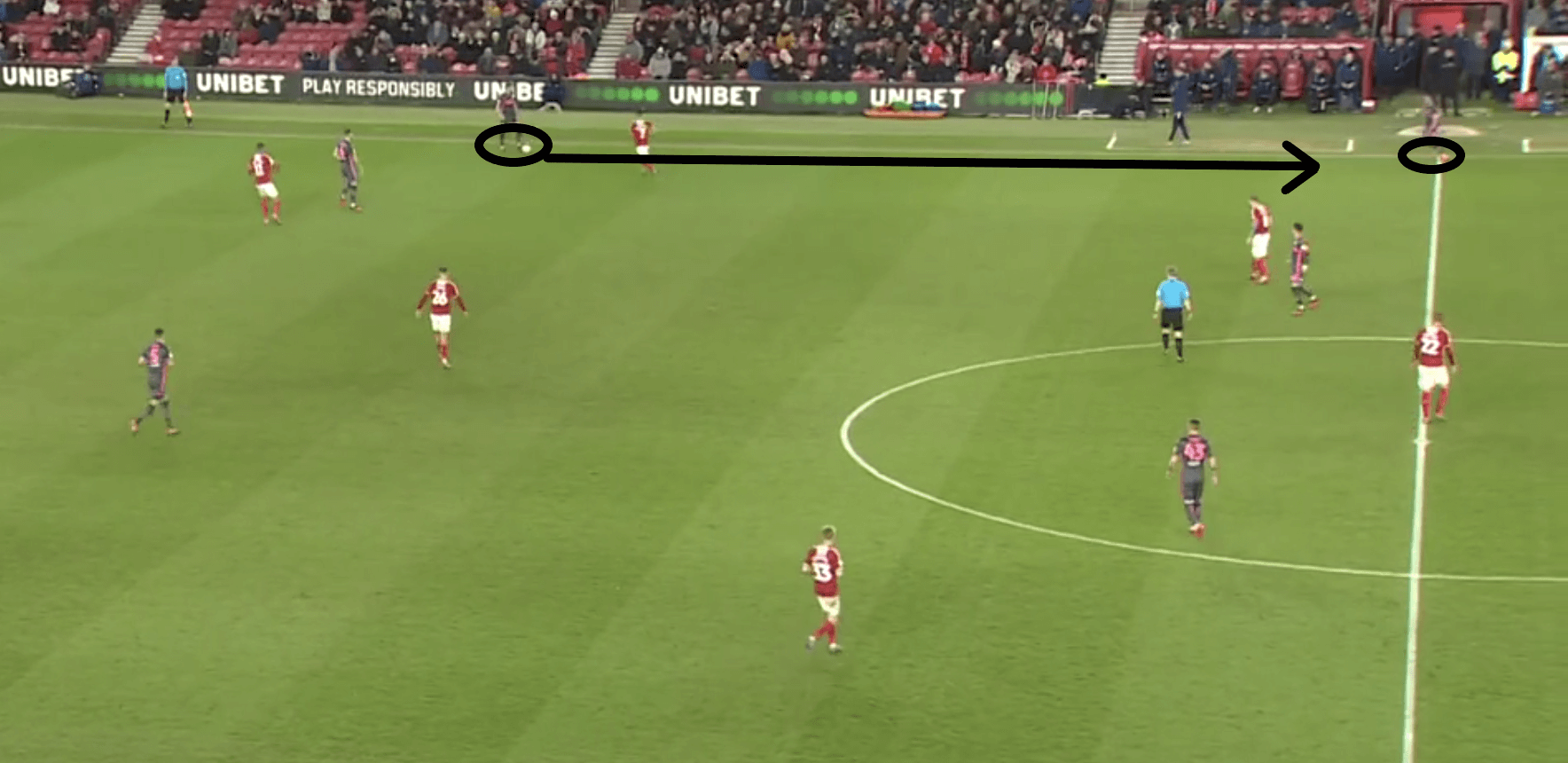
In the above scenario, Dallas has an open body position. Then the centre back passed to Dallas’ back foot. This instigated a press from the opposition. However, Dallas was composed and used his left foot to take the first touch. He kept the ball close whilst he opened up his body to face the opponent’s goal, then he quickly made a pass with his second touch to a teammate. This scenario happens regularly when Dallas plays as a full-back and Leeds are playing out from the back. His quick and simple touches help progress the play to the next stage in the flank.
When Dallas is deployed as a midfielder, his ability to keep the ball under close control also helps him keep possession. He will use his first touch to move the ball away from the defender, using his body as a shield. His first touch manoeuvres the ball so that he can pass with his second touch. By doing this he accomplishes two tasks with his first touch, he shields the ball from his opponent and controls the ball so that his second touch can be a pass without the need for too many touches. Now let’s examine an example of him being a midfielder below.
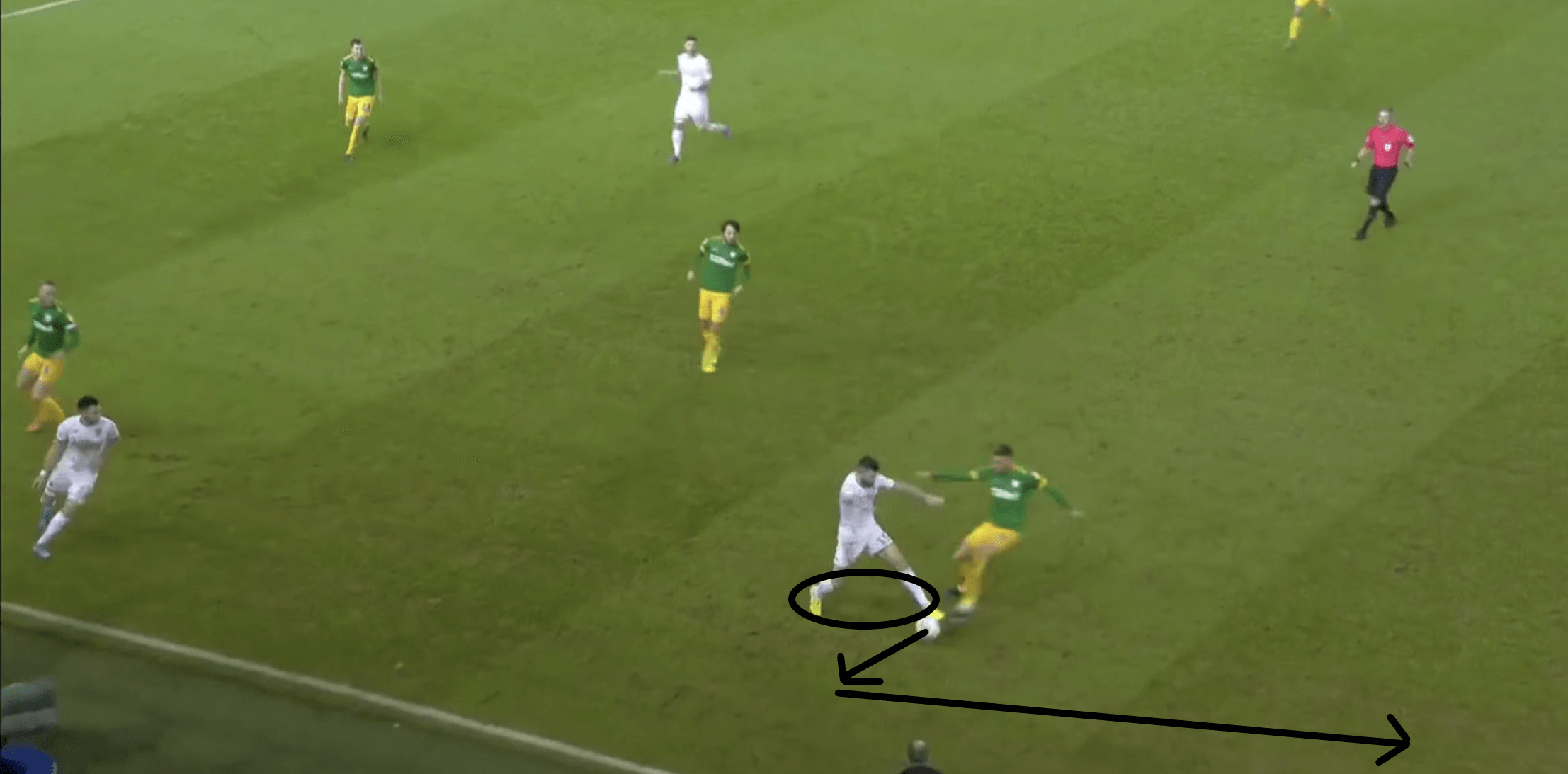
From the image above, we can see that Dallas uses his left foot to take his first touch and as the opponent challenged the ball, Dallas used his body as a shield to keep the ball away from the opponent. Then he took his first touch to evade the defender, whilst also getting into a position where he could successfully make a pass. His technique and ability enable him to fit in Leeds United’s tactics.
Ball Progression
In the last section, we’ve discussed the receiving technique of Dallas. Now let’s take a look at his ball progression. Bielsa’s tactics place a huge emphasis on the full-backs in getting the ball forward and into the next phase of build-up. Bielsa needs players who can not only pass forward under pressure, but can also pass to the area that a teammate can control with more success (such as passing to their back foot). That’s where Dallas really shows his talent. He averages 18.55 forward passes per 90, with an accuracy of 75.34%. He can use both feet to pick out his teammate in a more advanced position and even if he is pressed, he is able to complete the pass to his teammates’ strong foot or his back foot so that his teammate can go forwards with their first touch. Dallas’ range of passing is so vast that he is able to use the outsides of both feet to pass forward accurately. Below is an image that exhibits his excellent forward passing.
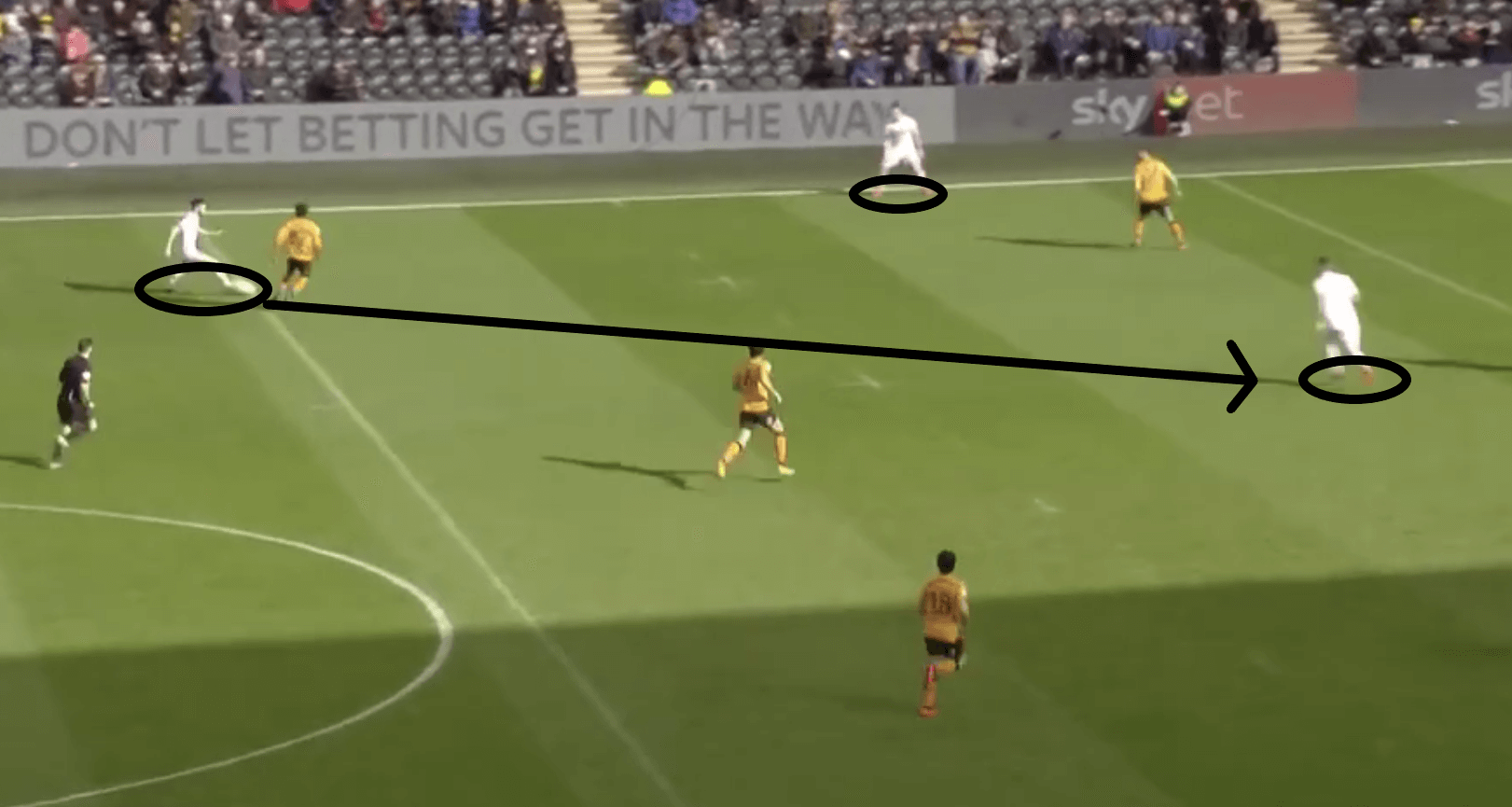
In the above scenario, Dallas featured as a left-back. He was closely pressed by his opponent and he didn’t have much space near the sideline. There was a passing option down the touchline that Dallas could easily complete. Nevertheless, Dallas didn’t pick the wide player. He took his first touch to evade the defender and then with his second touch he decided to use the outside of the right foot to pick out his teammate in the half-space area, make the pass into his teammate’s back foot, which allowed his teammate to receive on the turn and continue driving Leeds forward.
When playing as a midfielder, he can also pass to get Leeds into the attacking third or to create chances. He averages 7.29 passes to the final third and 3.48 passes to penalty area per 90, with accuracies of 68.65% and 44.07%. These passes can cut through defences and allow his teammates the chance to serve a killer pass or shot. Dallas is also capable of providing the shot assist himself. Now let’s check out one of the examples.
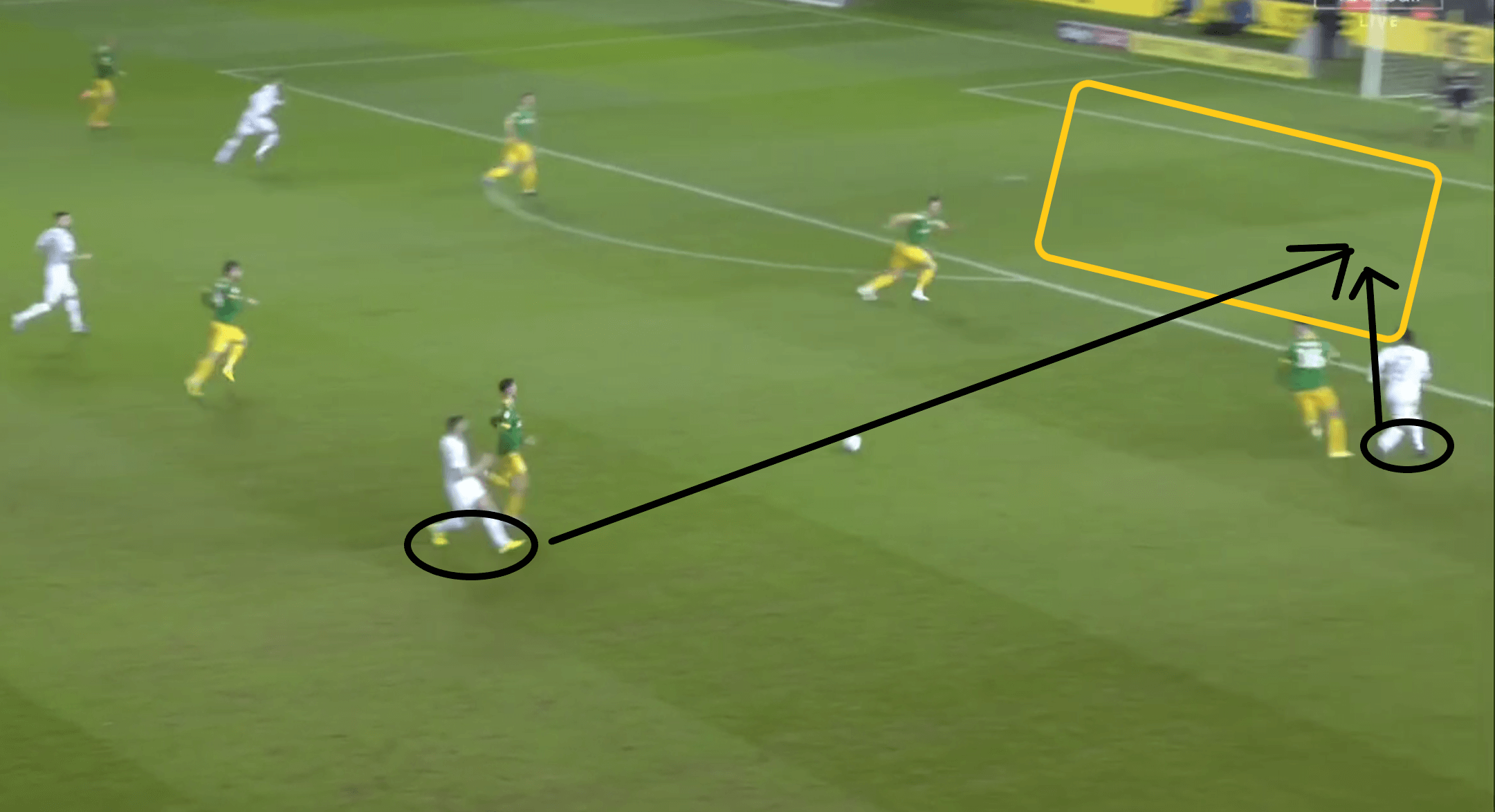
Leeds worked their attack into the final third and the opponent’s midfield line was bypassed and tried to recover. Dallas was the right centre midfielder in this match. He received the ball with his right foot and turned on the ball and was able to make a through pass with his second touch, splitting the opponent’s defensive line and into his teammate’s stride and his teammate could shoot with his first touch.
Apart from passing the ball forward, he can also utilise dribbling to progress the ball into the final third. He averages 2.03 dribbles per 90 and his technique in dribbling is also impressive, since he can keep the ball in close control without being dispossessed.
Dallas tends to dribble more often when he is deployed in the full-back position. This is due to Leeds’ pattern of play that utilises their full-backs passing and dribbling attributes. It can be demonstrated in the image below.
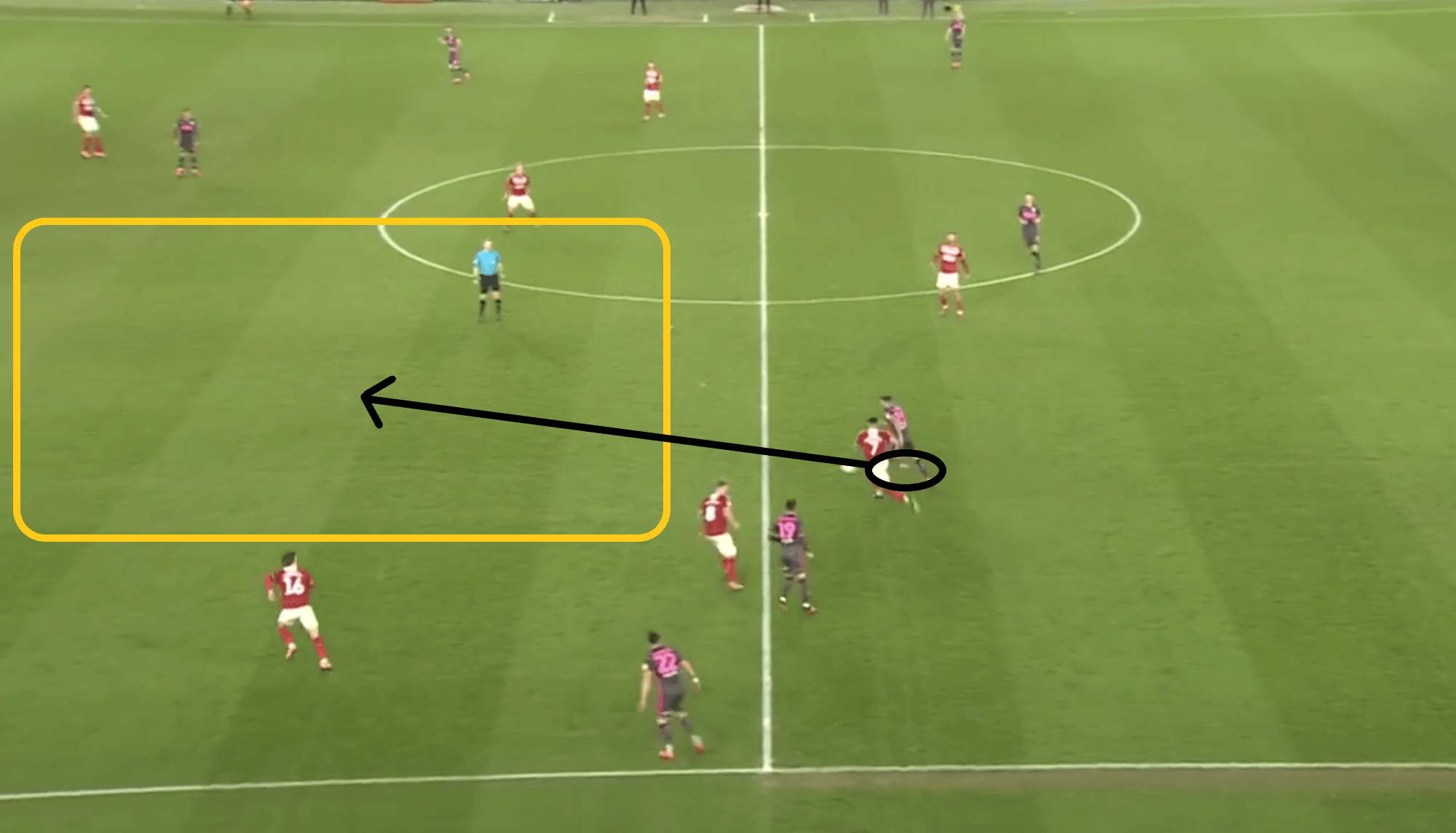
In the above scenario, Dallas was deployed as a left-back. One midfielder dropped to the sideline in the middle third. Dallas played a quick one-two with the aforementioned midfielder and dribbled into the space vacated by the defender. He received the ball in the half-space area and was unmarked due to his passing combination previously mentioned. He now had the space to drive with the ball and he dribbled into the final third. Leeds commonly use this pattern of play and we will discuss in more detail later.
Defensive approach
Leeds United’s philosophy is based on possession and attacking, so whenever they lose possession, they desire to win the ball back as fast as possible in transition from attacking to defending. They press when possession is lost and try to challenge the ball everywhere on the pitch. Under these tactics, players with a high-risk and ball-challenging mentality are favoured, and Dallas is one of them.
Dallas is 183 cm and weighs 83 kg, possessing a muscular physique and good speed, which are needed for combating tricky wingers. Dallas employs an aggressive approach in 1 v 1 defending. He gets goalside of his opponent and then as his opponent commits to the dribble, he tries to anticipate the trajectory of the ball and looks to intercept the ball before his opponent manages to dribble away, by using his physique and speed. He always challenges for the ball and attempts to win back possession for his team. Due to this sort of approach, he averages 3.8 interceptions and 7.39 recoveries per 90. Now let’s look at an analysis of his aggressive approach.
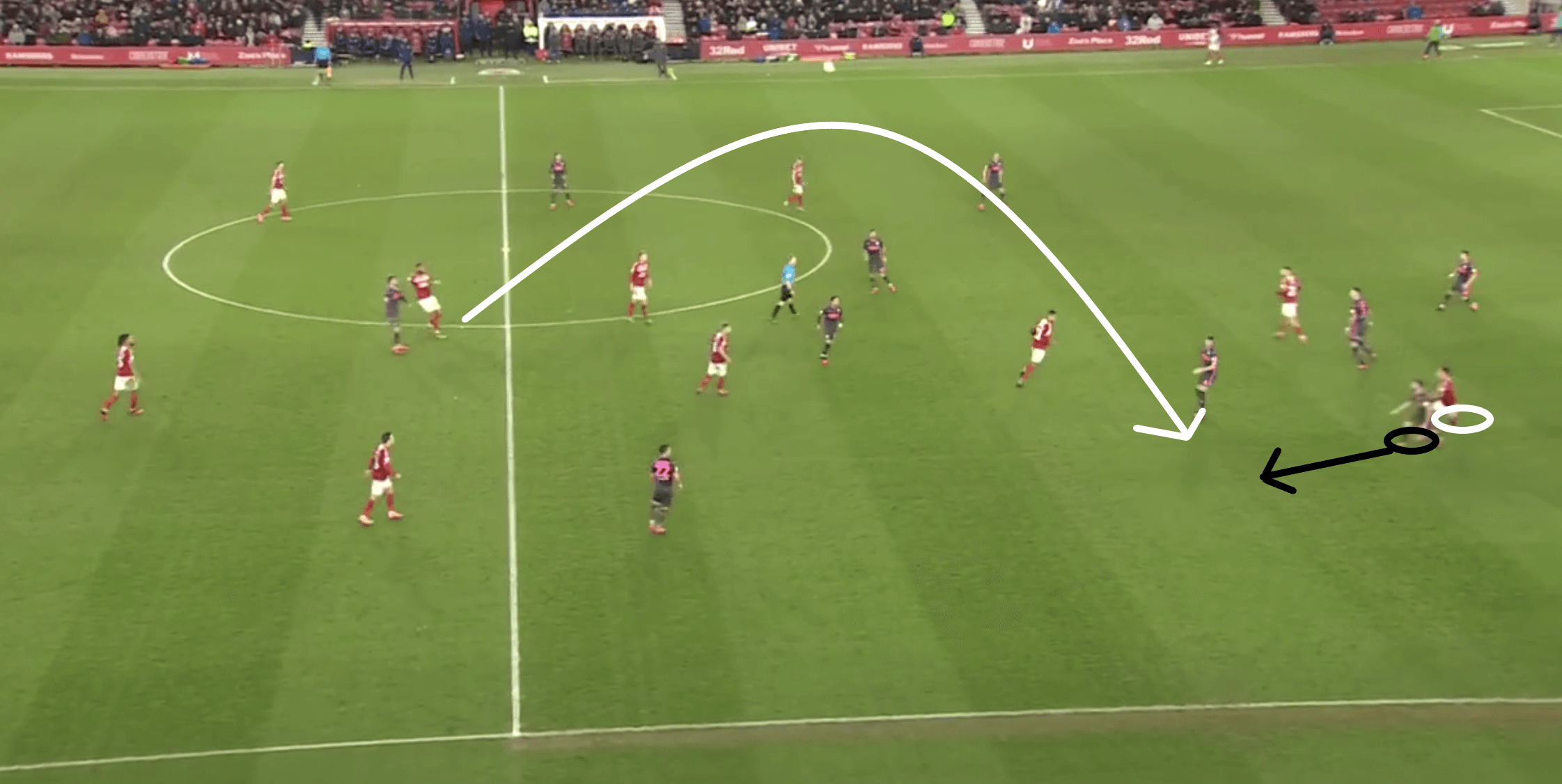
Dallas, as a left-back, was jostling with the opponent. He originally positioned himself goal side. Once the ball was passed, he immediately anticipated the route of the ball. He used his muscular physique to brush the opponent aside, outmuscling his opponent and getting in front of his. He intercepted the ball and he gained possession for his team.
Apart from being able to anticipate the play, he is also aggressive in 1 v 1 defending. When it comes to defending to prevent an opponent turning, he closes down his opponent, keeping close to them. Then he tries to poke the ball from behind to his teammate or directly win the ball back. When it comes to facing the attacker in 1 v 1, he tries to tackle and is able to recover is his tackle fails. This also helps regain possession when counter-pressing and when defending in own third. Now let’s take a look at an example of aggressive 1 v 1 defending in counter-pressing.
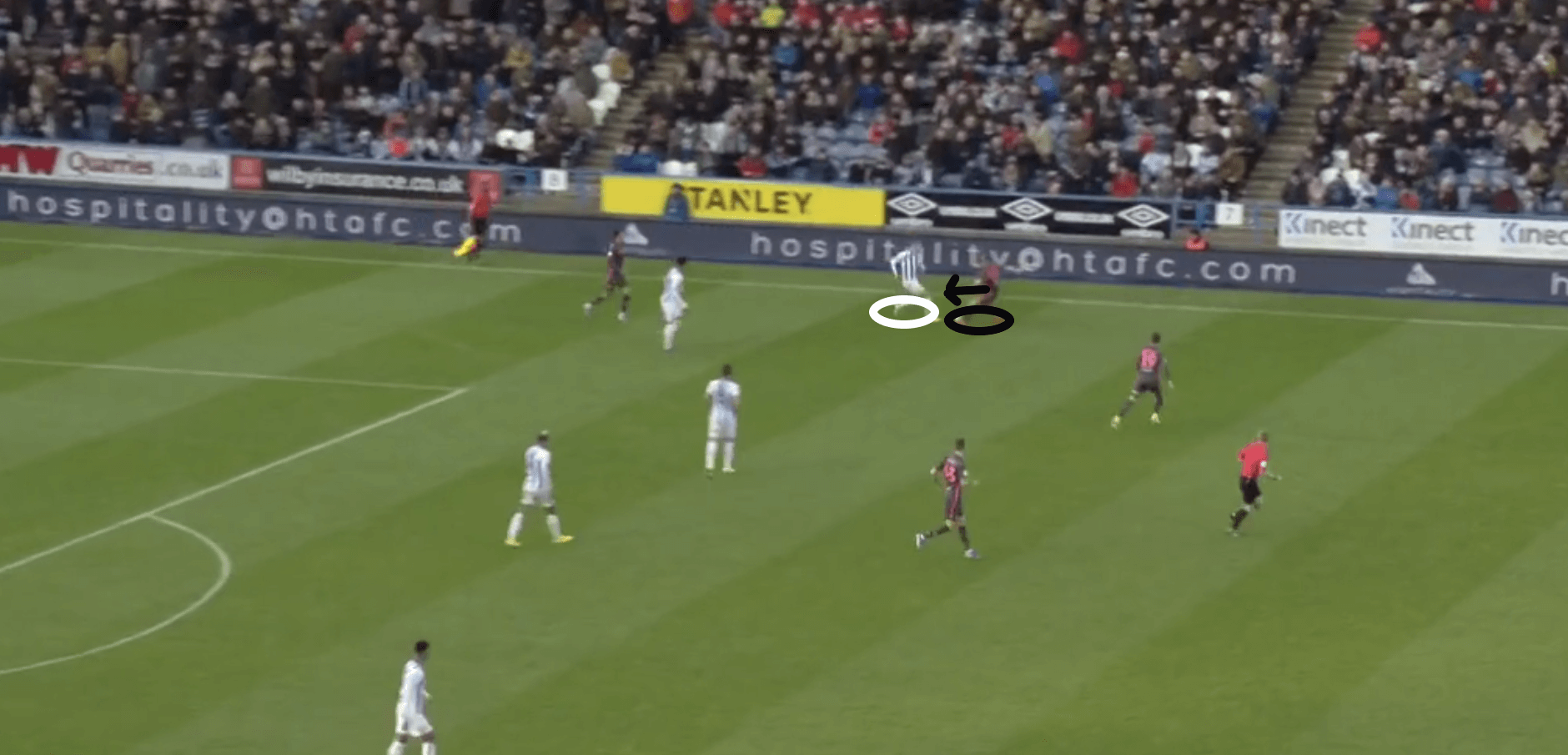
Dallas was playing as a right-back in this match. In the above scenario, their opponent gained possession in their third. Dallas was the nearest man to the ball. With his teammates covering his position, he engaged in a duel to win the ball, using his left foot to challenge for the ball. He succeeded and regained possession in the final third, enabling Leeds to launch a counterattack.
However, there are some risks to this approach. He has 1.19 fouls per 90, with 6 yellow cards. He can sometimes get too close to his opponent, making him easier to turn if his opponents first touch is good.
When playing as a full-back
After examining his attributes that make him suitable to be a Leeds United player, we will come down to the second question: his playing method in different positions. Now we will dive into the position of full-back.
To understand Dallas’ playing method of being a full-back, let’s talk about the role and responsibility of full-backs in Leeds United’s tactics first. First of all, in the formation of 4-1-4-1, there will be a triangle on the flank. This is the key to Leeds United’s flank play, when building up, penetrating and finishing stage. The players in this triangle are able to rotate, which we mentioned in the ball progression part. Now let me explain to you the pattern play, that utilises a triangle shape when playing out from the back and also progressing in the midfield.
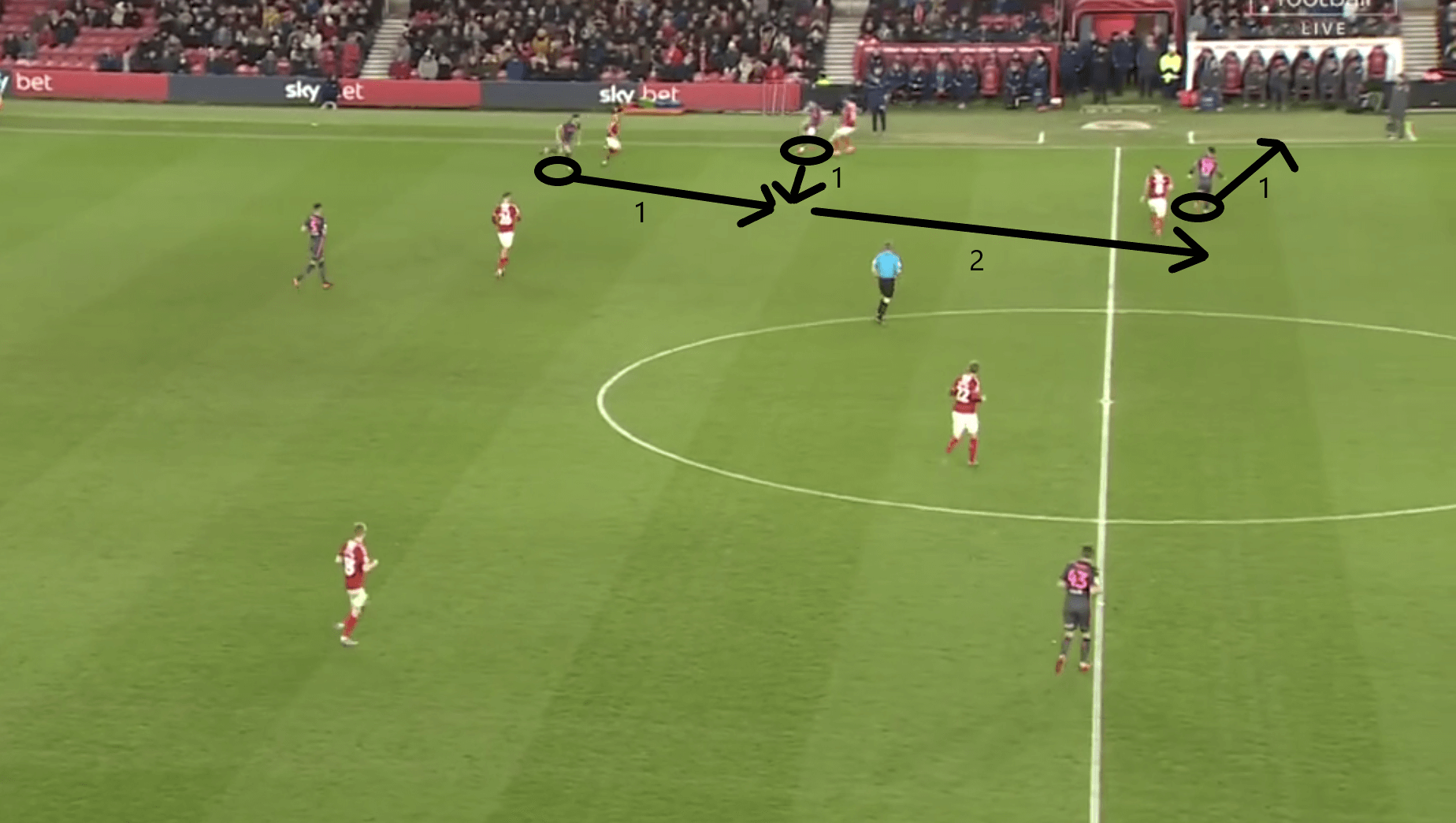
The above image shows the initial position of the flank-trio. The left-winger and the left-back are occupying the sideline, while the left central midfielder is occupying the half-space. The opponents have overloaded the ball side, restricting the space that Leeds United could use. That’s when the rotation triangle comes into play.
As the ball was played by Dallas at left-back, the winger dropped, dragging the opponent’s full-back out of position, and the midfielder diagonally rushed to the side pulling a defender with him, which created a central channel. After the ball was released, left-back Dallas underlapped to the half-space channel, ready to receive the 1-2 pass from the winger. Then let’s take a look at the result of this rotating triangle.
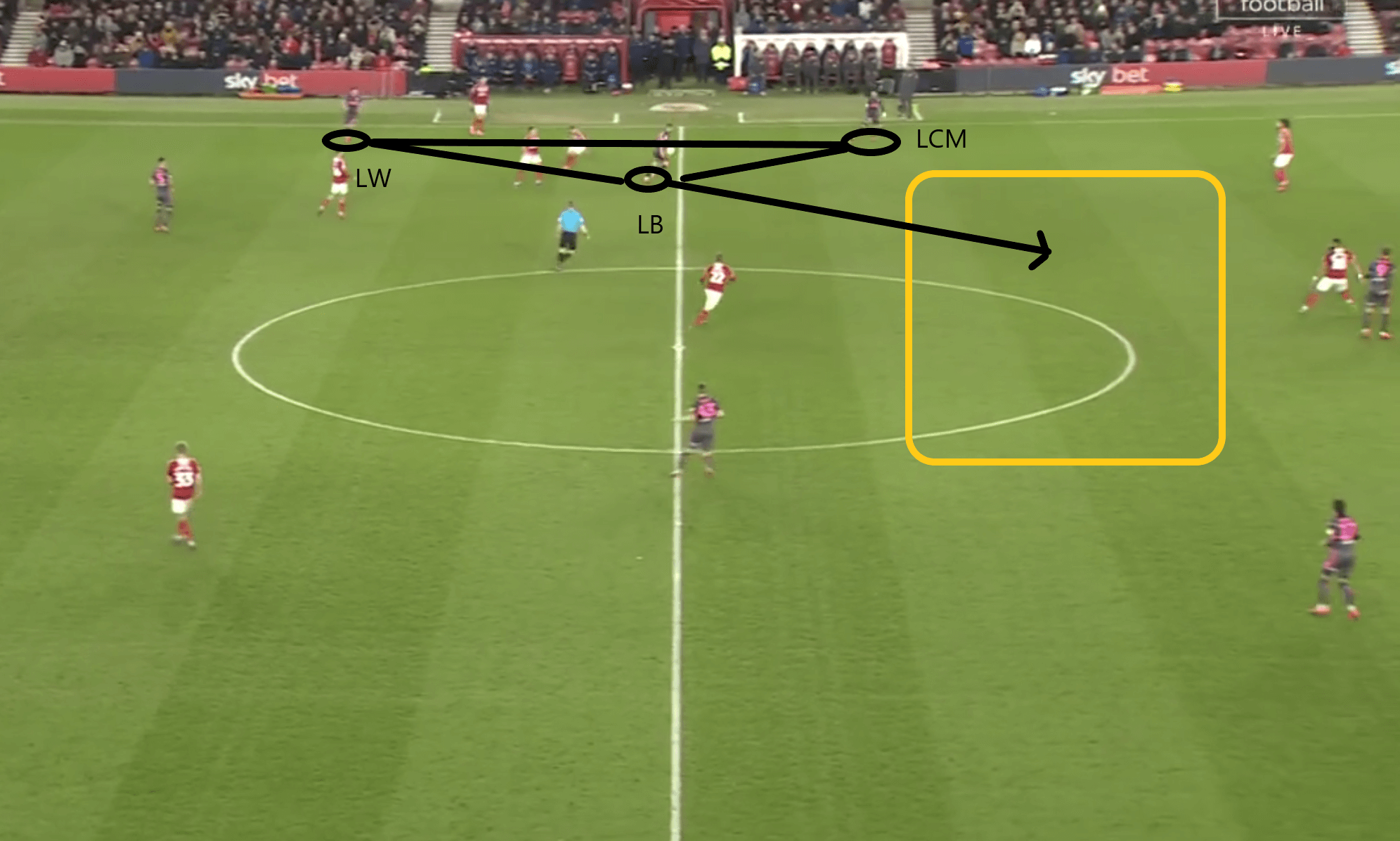
Now the half-space channel had no defenders and there was a lot of space in the midfield to dribble. Dallas receives the 1-2 pass from the winger, and the winger became the bottom tip of the triangle, while the midfielder occupies the space out-wise, meaning Dallas could dribble into an open half-space. That was when his dribbling could fully be taken advantage of. Dallas dribbled into the final third, creating a goal-scoring opportunity for his teammate.
Now we understand the pattern of the triangle flank play. We can see that in this flank play Dallas will run inside into the half-space channel. Then he has the responsibility to drive Leeds into the final third. Furthermore, this can also explain why Bielsa sees him as a suitable player for the left-back role, whilst at the beginning of this season, he started as a right-back for several matches. One reason is that Bielsa could use Dallas’ dribbling more effectively. Dallas is right-footed, which means cutting inside from the left flank is more likely, since it will be more reasonable to cut inside onto this favoured foot and it also has the benefit of being able to use his body to shield the ball.
Apart from this progressive rotation move of Leeds’ tactics when he plays as a left-back, he takes a slightly different role when playing at right-back, especially in the final third. He focuses on crossing a lot more and making overlapping runs. There will still be a rotating triangle, but with different patterns.
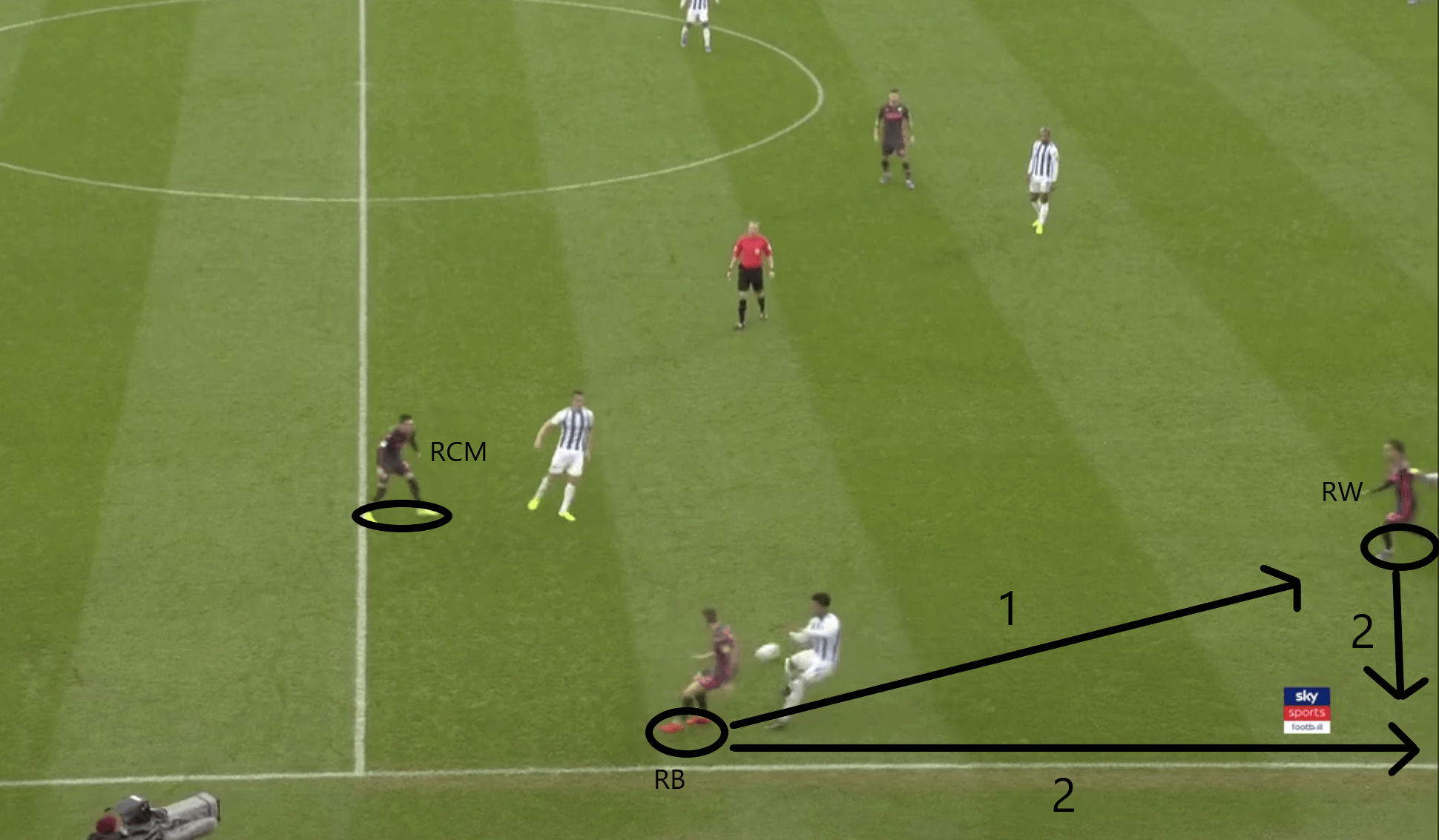
As you can see from the above example, the right central midfielder, right-winger, and right back Dallas, together form a triangle. First, the midfielder passes to Dallas, who uses the outside of his foot to pass with his first touch and follows up by a playing an overlapping 1-2 with the winger.
After analysing his role and playing style in possession, let’s analyse his playing style when out of possession as a full-back. Since Leeds United are a team that like to press and want to gain an advantage by defending high, it’s crucial that any opposite players without the ball are marked or their passing lanes blocked. We can interpret it as man-marking, which can contribute to intense pressing when an opponent receives the ball. Dallas is no exception.
When dealing with 4-2-3-1 and 4-3-3 formations, there will be a natural winger for him to mark, and he marks tight. Instead of adopting a zonal marking approach, he employs a man-marking approach, which is his aggressive style of play. He will follow his opponent even if they have roamed out of position to receive the ball in space, Dallas follows and ensures he marks them closely
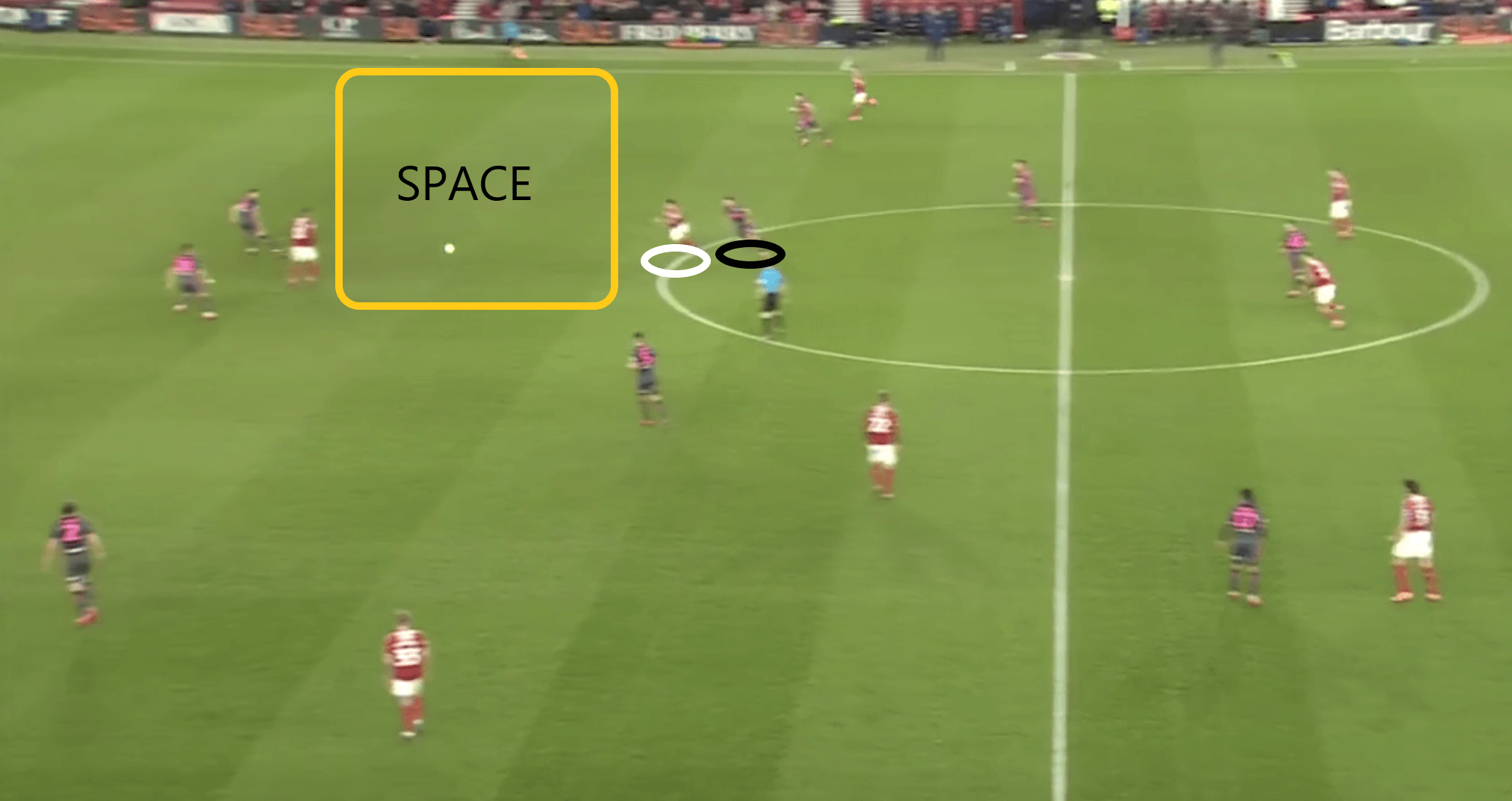
In this scenario, he was marking the opponent’s right-winger. The winger dropped deep and Dallas followed, marking his tightly. However, adopting this kind of approach, instead of passing on marking responsibilities with his teammates, can leave space in behind where you would expect to find Dallas.
When playing as a midfielder
After diving into the position of full-back, let’s check out the analysis of the midfielder position. In the attacking phase, he is still in the triangle pattern of play, although his position has changed. This means that he would have a different off-the-ball movement in this case. In playing out from the back and progressing through the midfield, he will have 2 roles. The first one is the rotating movement, creating space for the out-in runs from the full-backs, which we discussed in the last section.
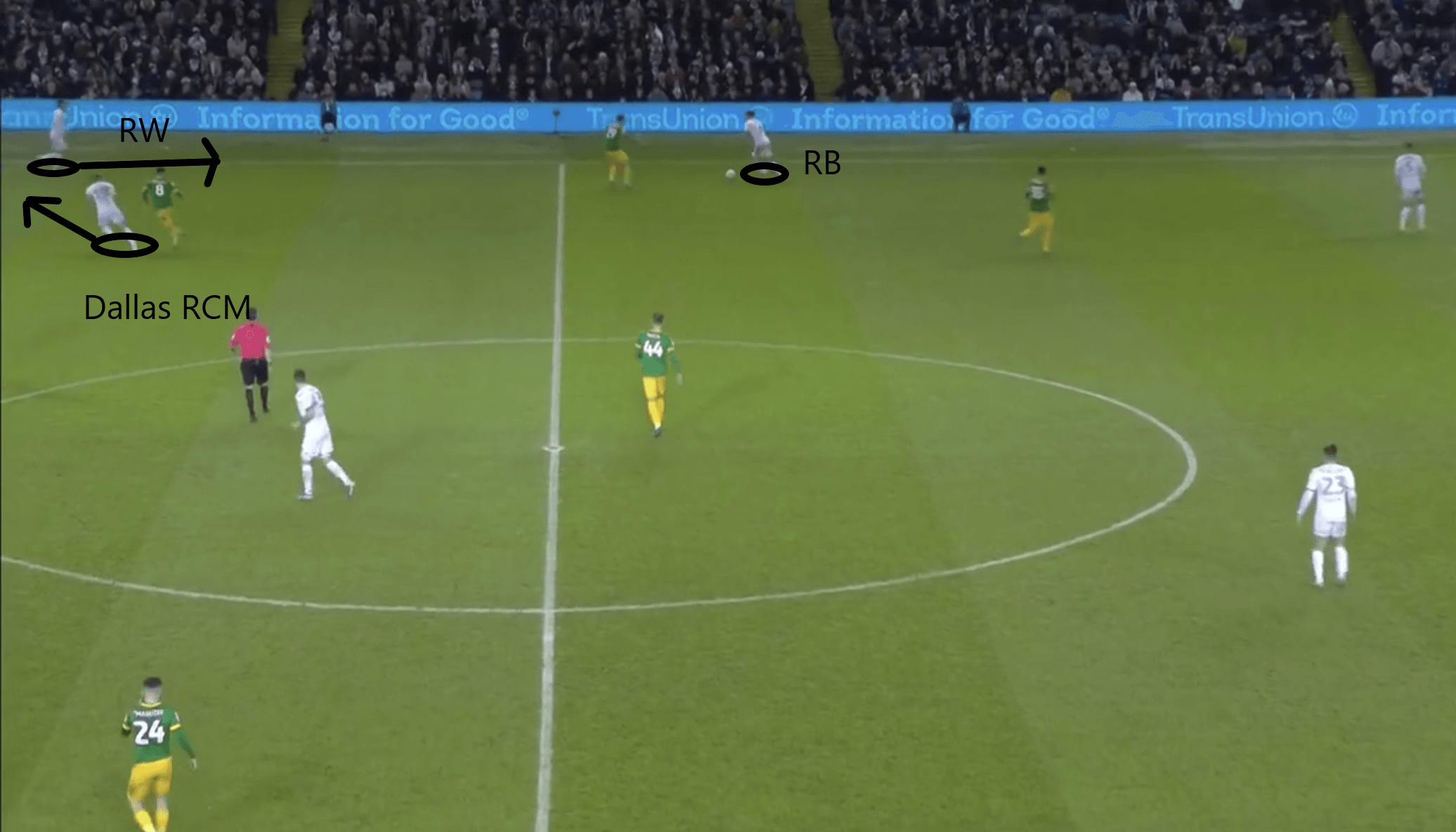
In the above image, Dallas is playing as a right centre- midfielder, he makes a diagonal run towards the sideline and drags the opponent’s midfielder out of position. This creates space that the full-back is able to dribble into, which we discussed in the last section. In the second, he acts as a lateral or back passing for his teammates, as he is facing forwards, his teammates can pass to Dallas and he is able to play forwards.
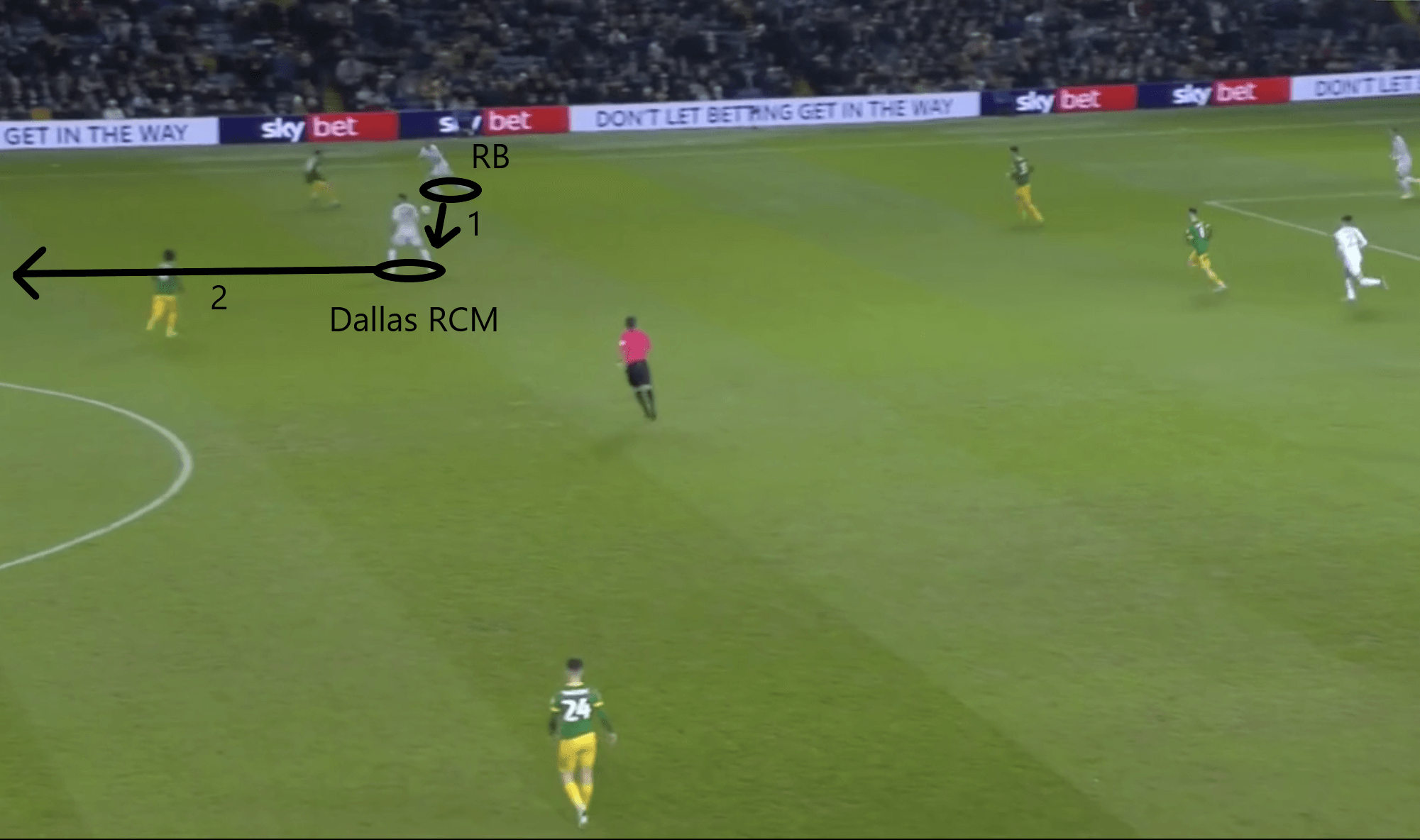
In the above scenario, Leeds United are trying to play out from the back. The right full-back received the ball and passed to the right central midfielder, Dallas. In this case, Dallas was a lateral passing option. He checked his shoulder before receiving the ball, so that he could scan any forward passing options. When receiving the ball, Dallas managed to play a first time pass into the final third.
Further to this, the goalkeeper often passes to Dallas in the build-up in order to assist Leeds in succeeding in their plan of playing out from the back. If an opposing team is pressing high, the Leeds goalkeeper can play a long ball towards Dallas, who is able to control the ball and helping Leeds beat the opposition press.
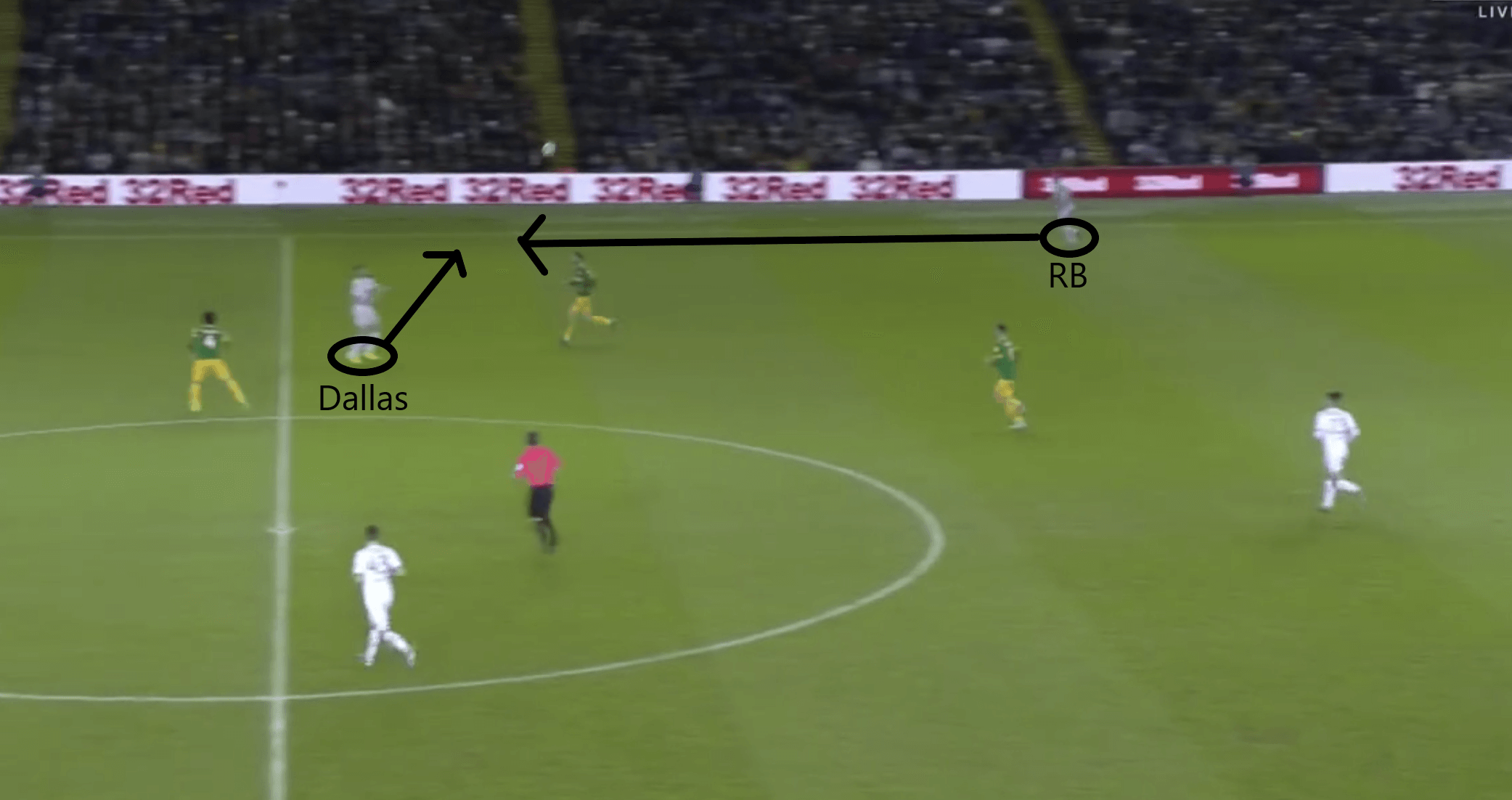
In this scenario, the goalkeeper hits a long pass to find Dallas in the midfield. Dallas was able to read the flight of the ball and passed the ball with his first touch, laying the ball off to the right full-back who was facing forward.
Conclusion
We delved into Stuart Dallas’ attributes and also his contribution when playing in different positions. After this tactical analysis, we think that when the EFL Championship returns, he will probably continue in his role at left-back. He contributes a lot in progressing the play at that role.
If Leeds are promoted, the versatile Stuart Dallas will be able to contribute more as Leeds United step in the Premier League next season. We can also wait to see if he plays at other positions in the future.




Comments